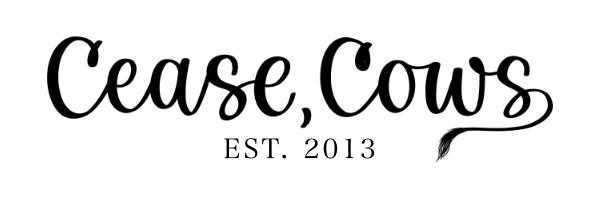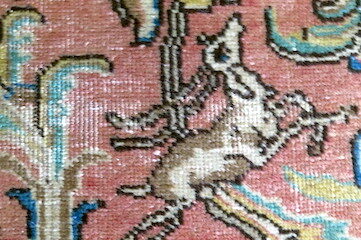You are scrambling eggs for breakfast when you hear your three-year-old giggling in the other room.
“Come eat,” you call and hear another giggle.
You find her in the foyer, sitting at the end of the hallway runner staring into the rug.
“What are you doing?” you ask, squatting down beside her.
“It’s a funny story,” she says and points to a shape on the rug.
You scrunch down to try to see the rug from her perspective. “What’s a funny story?”
“The donkey. He knocked over the apples.” Millie laughs again, a burbling sound like water rushing around rocks. “He’s so silly.”
You look where she is pointing, and there is the image of spilled bushel of apples in the tight loops of the rug. You see the donkey that Millie is attributing the apple spill to. The rug is full of tiny scenes like this: A seated man plays a lute, a woman in a blue gown carries a bowl, men on horseback waving flags gallop toward the center field.
The hallway runner had been a yard sale find. You figured it was some kind knock off made to look like a medieval tapestry. It is subtly colored, fits the space, and—best of all—only cost you $30.
“Wow, there’s a whole world on here,” you tell her. “Do you have a favorite?”
Millie points to a woman doing what looks like needlework with a small brown dog seated at her feet.
“She is the nicest,” Millie whispers.
“She does look nice,” you say. “Now let’s have some breakfast. We have a lot to do today.”
When you first brought the rug home, you would occasionally find your old tabby staring at it. You figured she probably smelled some former pet in the fibers and was just standing guard just in case that dog or cat materialized.
The following week, you don’t see Millie watching the rug again, but you find you can’t stop glancing at it whenever you walk through the foyer. Each time you look down you see something new—a unicorn standing between two white birch trees, an infant in a low wooden cradle.
Then one night, as you are leaving for a dinner party with your husband, you notice the bushel is upright and full of apples again, right there by your strappy-sandaled foot.
“The apples,” you say without realizing it, stepping off the runner.
“Are we supposed to bring apples?” your husband asks, holding your coat.
You bend over and see that the girl isn’t doing needlework anymore. She is throwing a ball for the dog. And the man isn’t playing the lute. Instead, he holds a foamy stein high in one hand as if he is making a toast.
“What’s wrong?” Your husband sounds alarmed. He bends over beside you and looks at the floor, blocking the light. “Did you lose an earring?”
“No,” you say, straightening. “I’m fine. We should go.”
Your husband writes some numbers down on a notepad in the kitchen for the sitter. You pretend to pick cat hair off of your slacks as you scan the figures on the runner. You don’t see the donkey anywhere.
When you returned from dinner, you check the rug again.
“Everything ok?” your husband asks as he turns off the lights in the kitchen.
“Everything’s great,” you say and smile at him before hanging your coat in the hall closet.
The next morning, after he leaves for work, you kneel in foyer and check the rug again. The unicorns are grazing in the field, the woman in blue cuddles the infant from the wooden cradle, the dog asleep at her feet. The donkey isn’t anywhere.
You flip up the corners of the rug looking for a tag, information about its origin. Millie, still in her pajamas, comes into the foyer to find you. You can hear cartoon music coming from the TV in the family room.
“What are you doing?” she asks and leans against you.
“I can’t find the donkey anywhere,” you tell her. “I don’t where he’s gone.”
She tilts her head and then gets down on all fours to take a closer look. Then she sits up suddenly.
“Did you find him?” you ask and try to sound casual.
She points to one corner of the runner. You move to where she is sitting, and there is a large woman in a wimple you have never seen before. Her arms are crossed, and she is glowering at you. There is no mistaking the anger on her face, even in the tight loops of the rug.
“I think it is a secret,” Millie whispers.
–
Colleen Kearney Rich is the author of the chapbooks Things You Won’t Tell Your Therapist (Finishing Line Press, 2019) and Bunnyman Bridge (A3 Press). Her writing has been published in the literary journals SmokeLong Quarterly, Wigleaf, Matchbook, and Pithead Chapel, among others. One of the founding editors of So to Speak: A Feminist Journal of Language and Art, she has an MFA from George Mason University in Virginia, where she also works.
Lead image: “Antique Tabriz with Deer” *with edits* (via Flickr user Carpetbeggers)

